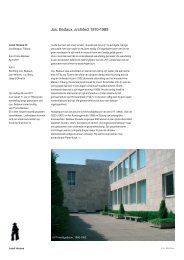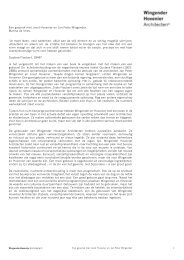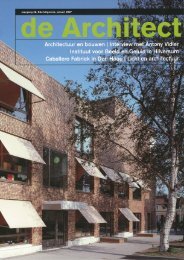Berlin 2009 - Wingender Hovenier Architecten
Berlin 2009 - Wingender Hovenier Architecten
Berlin 2009 - Wingender Hovenier Architecten
Sie wollen auch ein ePaper? Erhöhen Sie die Reichweite Ihrer Titel.
YUMPU macht aus Druck-PDFs automatisch weboptimierte ePaper, die Google liebt.
Kunstgalerie Kupfergraben, <strong>Berlin</strong>, 2003-2007<br />
David Chipperfield<br />
This Art Gallery is located on number<br />
10 of <strong>Berlin</strong>’s Kupfergraben canal,<br />
overlooking the Lustgarten, a park<br />
presided by the Altes Museum by<br />
Schinkel and the Museum Island.<br />
The intention was to build a modern<br />
building which incorporated but did<br />
not replicate the past. As part of the<br />
cityscape, the composition of the fourstorey<br />
gallery building reacts to its<br />
immediate historic context, while the<br />
scale of its window openings reflects<br />
the urban dimensions of a corner<br />
building. As an urban infill, the new<br />
building connects with both of its<br />
neighbouring buildings with regard to<br />
their respective building heights and<br />
occupies the footprint of the preceding<br />
building (destroyed during the war),<br />
while at the same time developing its<br />
own sculptural quality. The facades are<br />
of brick masonry on reconstituted stone<br />
courses with no visible expansion joints,<br />
using salvaged bricks pointed with<br />
slurry, which gives the surface an<br />
interesting texture in ocre tones that<br />
reacts to sunlight. This arrangement<br />
rests at regular intervals on concrete<br />
courses that structure the composition<br />
and place the gallery in relationship<br />
with the cornice lines of the adjacent<br />
historical buildings. Large window<br />
openings reflect the urban scale of the<br />
site and define the composition of the<br />
facade, given structure by their<br />
untreated wooden sashes. They also<br />
provide extraordinary views over the<br />
monumental complex of <strong>Berlin</strong>. In<br />
contrast, the facade that looks onto the<br />
courtyard is entirely enclosed with glass<br />
and wood, generating a more domestic<br />
image than the exterior ones in spite<br />
of the repeated series of windows that<br />
cover its surface. The structure of the<br />
complex is made out of reinforced<br />
concrete. While solid materials that will<br />
age well characterise the exterior of the<br />
building, the interior is defined by<br />
daylight and proportion. The building<br />
cores organise the space of the 5.5<br />
metre high rooms. The floor plan,<br />
consisting of a simple scheme of<br />
longitudinal bands, varies throughout<br />
the four storeys depending on the form<br />
of the volume and the placement of the<br />
window openings. The gallery spaces<br />
are side lit from different directions, and<br />
daylight is controlled by interior folding<br />
shutters. The intention was to create a<br />
series of well proportioned and well lit<br />
rooms for living, working, or showing art<br />
- in a townhouse dedicated to the arts<br />
and directly related to the cultural heart<br />
of the city and its history.





